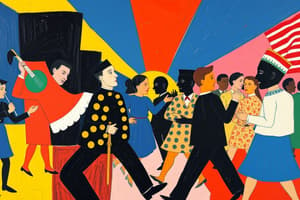Podcast
Questions and Answers
What does the term 'American Century' refer to?
What does the term 'American Century' refer to?
A time following World War II when America was confident in its growing power.
Who was Henry Luce?
Who was Henry Luce?
Publisher of Time, Life, and Fortune magazines.
What is the Bretton Woods Agreement?
What is the Bretton Woods Agreement?
An international financial agreement that created the World Bank and the International Monetary Fund.
What is business consolidation?
What is business consolidation?
What are blue collar workers?
What are blue collar workers?
What are white collar workers?
What are white collar workers?
What are pink collar jobs?
What are pink collar jobs?
Who is Michael Harrington?
Who is Michael Harrington?
What does consumerism refer to?
What does consumerism refer to?
What are credit cards?
What are credit cards?
What is the Diner's Club Card?
What is the Diner's Club Card?
What does 'In God We Trust' represent?
What does 'In God We Trust' represent?
What is the term 'Under God' associated with?
What is the term 'Under God' associated with?
What is the Military-Industrial Complex?
What is the Military-Industrial Complex?
What is the GI Bill of Rights?
What is the GI Bill of Rights?
What are multinational corporations?
What are multinational corporations?
What does the service sector refer to?
What does the service sector refer to?
Who is John Kenneth Galbraith?
Who is John Kenneth Galbraith?
What is planned obsolescence?
What is planned obsolescence?
What is leisure time?
What is leisure time?
What is Levittown?
What is Levittown?
Who is William Levitt?
Who is William Levitt?
What are suburbs?
What are suburbs?
What is redlining?
What is redlining?
What is 'White Flight'?
What is 'White Flight'?
What is a franchise?
What is a franchise?
Who is Ray Kroc?
Who is Ray Kroc?
What did the National Housing Act of 1949 do?
What did the National Housing Act of 1949 do?
What does Title I refer to?
What does Title I refer to?
What is The Sunbelt?
What is The Sunbelt?
What is the Interstate Highway Act of 1956?
What is the Interstate Highway Act of 1956?
What are benefits of car culture?
What are benefits of car culture?
What are drawbacks of car culture?
What are drawbacks of car culture?
What is the Baby Boom?
What is the Baby Boom?
Who is Dr. Spock?
Who is Dr. Spock?
Who is Jonas Salk?
Who is Jonas Salk?
Who is Betty Friedan?
Who is Betty Friedan?
What is 'The Feminine Mystique'?
What is 'The Feminine Mystique'?
What was the significance of Griswold v. Connecticut (1965)?
What was the significance of Griswold v. Connecticut (1965)?
What were some popular TV shows of the 1950s?
What were some popular TV shows of the 1950s?
What is rock n' roll?
What is rock n' roll?
Who is Alan Freed?
Who is Alan Freed?
Who is Elvis Presley?
Who is Elvis Presley?
Who is Sam Philips?
Who is Sam Philips?
Who is Little Richard?
Who is Little Richard?
Who is Chuck Berry?
Who is Chuck Berry?
Who is Ed Sullivan?
Who is Ed Sullivan?
Who is Dick Clark?
Who is Dick Clark?
'American Bandstand' started airing in what year?
'American Bandstand' started airing in what year?
What is The Beat Movement?
What is The Beat Movement?
What are beatniks?
What are beatniks?
What does the Federal Communications Commission (FCC) do?
What does the Federal Communications Commission (FCC) do?
Who is Jack Kerouac?
Who is Jack Kerouac?
Who is James Dean?
Who is James Dean?
Flashcards are hidden until you start studying
Study Notes
American Century
- Coined by Henry Luce, signifies post-World War II confidence in U.S. global power and influence.
Henry Luce
- Influential publisher behind Time, Life, and Fortune magazines; envisioned the rise of "the American Century."
Bretton Woods Agreement
- Established in 1944, created the International Monetary Fund and the World Bank, shaping post-war international finance.
Business Consolidation
- A trend where companies buy out competitors, leading to fewer but larger corporations.
Blue Collar Workers
- Manual laborers earning lower wages; common occupations included construction and factory work prior to the 1950s.
White Collar Workers
- Skilled workers in management and technical jobs; marked a shift with higher wages and job prestige emerging in the 1950s.
Pink Collar Workers
- Occupations typically filled by women, predominantly in service sectors with lower wages and minimal status.
Michael Harrington
- Author of "The Other America," highlighting hidden poverty in the U.S., unveiling stark economic disparities.
Consumerism
- Emergence of material goods as a measure of success, reflecting a growing culture of consumption.
Credit Cards
- Introduced "buy now, pay later" model; signaled a shift toward consumer credit usage.
Diner's Club Card
- First credit card, launched in 1950, revolutionizing payment methods and consumer purchasing behavior.
"In God We Trust"
- Motto mandated by law on U.S. currency in 1955, reflecting the era's religious sentiment.
"Under God"
- Phrase added to the Pledge of Allegiance to emphasize national faith.
Military-Industrial Complex
- Term introduced by Eisenhower, warning against the strong relationship between military interests and defense contractors, which could lead to excessive spending.
GI Bill of Rights
- Provided veterans with benefits for education, housing, and loans, contributing significantly to post-war economic expansion.
Multinational Corporations
- Large companies operating across borders, reflecting globalization trends post-World War II.
Service Sector
- Economic segment focused on services like healthcare and education, contrasting with manufacturing industries.
John Kenneth Galbraith
- Economist known for "The Affluent Society," analyzing the peculiarities of post-war prosperity and public service needs.
Planned Obsolescence
- Business strategy aimed at making products outdated quickly to encourage continual consumer spending.
Leisure Time
- Increased time for recreation due to 40-hour work weeks and labor-saving devices; led to new cultural activities like TV viewing.
Levittown
- Mass-produced suburban housing that addressed post-war shortages, becoming emblematic of suburban expansion.
William Levitt
- Real estate developer who popularized assembly-line housing techniques, fostering suburban growth.
Suburbs
- Residential zones around cities that became popular post-WWII, attracting families and businesses alike.
Redlining
- Discriminatory housing practice restricting minority access to home purchases in certain neighborhoods; now illegal.
"White Flight"
- Demographic trend where white middle-class families moved from racially diverse areas to predominantly white suburbs.
Franchise
- A business model allowing replication of products/services across numerous locations, fostering brand familiarity.
Ray Kroc
- Key figure in McDonald's expansion, acquiring the restaurant chain from its original founders.
National Housing Act of 1949
- Initiated extensive low-income housing projects to address urban decline and build affordable living spaces.
Title I Projects
- Government initiatives aimed at creating housing solutions for lower-income families.
The Sunbelt
- A region from Florida to California known for its favorable climate and economic opportunities, attracting post-war migration.
Interstate Highway Act of 1956
- Massive infrastructure project creating an extensive highway system, changing American transportation and suburban life.
Benefits of Car Culture
- Economic boom in tourism, entertainment (drive-ins), and accessibility to parks and historical sites.
Drawbacks of Car Culture
- Increased pollution, road accidents, and urban traffic congestion resulting from car dependency.
Baby Boom
- Demographic surge of births between 1946 and 1964 due to post-war optimism, leading to a youth-centric culture.
Dr. Spock
- Influential child-rearing expert whose advice shaped parenting philosophies during the Baby Boom.
Jonas Salk
- Medical pioneer who developed the polio vaccine in 1952, significantly impacting public health.
Betty Friedan
- Feminist author of "The Feminine Mystique," credited with igniting the Second Wave of feminism by highlighting women’s issues.
The Feminine Mystique
- Explores the dissatisfaction of middle-class women, advocating for gender equality and greater fulfillment.
Griswold v. Connecticut (1965)
- Supreme Court ruling affirming privacy rights, allowing women's access to contraception, a landmark in reproductive rights.
Popular TV Shows
- Iconic shows of the era included "I Love Lucy," "Mickey Mouse Club," and "Gunsmoke," highlighting shifts in entertainment.
Rock 'n' Roll
- Musical genre blending rhythm and blues with other styles, catalyzed by African American artists for broader audiences.
Alan Freed
- Pioneering DJ who promoted African American music, playing a crucial role in popularizing rock 'n' roll.
Elvis Presley
- Cultural icon credited with mainstreaming rock 'n' roll, merging diverse musical influences and styles.
Sam Philips
- Music producer known for launching Elvis Presley’s career and founding Sun Studios, key to rock n' roll history.
Little Richard
- Influential African American rock musician known for his energetic performances and hit song "Tutti Fruiti."
Chuck Berry
- Legendary rock 'n' roll musician whose style laid the groundwork for future rock artists and genres.
Ed Sullivan
- TV host of "Toast of the Town," a major platform for promoting new music and cultural trends in the 1950s.
Dick Clark
- Prominent figure in rock promotion, known for hosting "American Bandstand," which showcased emerging musical talent.
"American Bandstand"
- A dance show featuring rock hits, pivotal in popularizing the rock genre and shaping youth culture in America.
The Beat Movement
- Counter-culture group of the 1950s that challenged societal norms through literature and social critique.
Beatniks
- Youth subculture rebelling against conventional values, known for their unique style, poetry, and exploration of drugs.
Federal Communications Commission (FCC)
- Regulatory body overseeing communications in radio, TV, and telecommunications, shaping media landscape.
Jack Kerouac
- Leading figure of the Beat generation, author of "On the Road," capturing the spirit and struggles of the era.
James Dean
- Cultural icon representing teenage rebellion and disillusionment in the 1950s, known for his role in "Rebel Without a Cause."
Studying That Suits You
Use AI to generate personalized quizzes and flashcards to suit your learning preferences.




